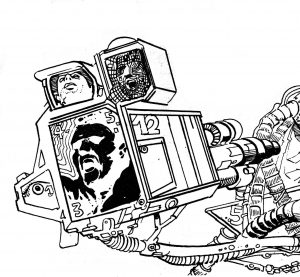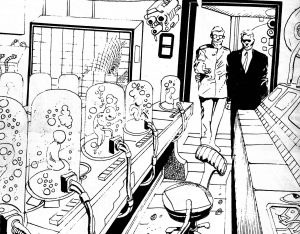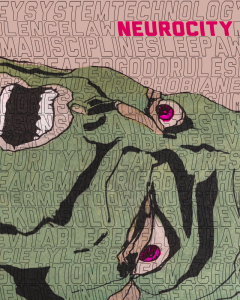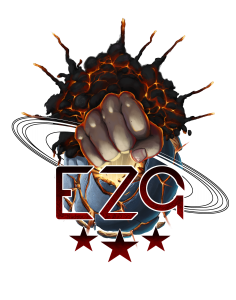Neurocity (Unique System) (Priority Review)
So, this game clocks in at 128 pages, 1 page front cover, 1 page back cover, 2 pages editorial/credits, 10 pages blanks/separators, 1 page ToC, 3 pages of KS-thanks, leaving us with 110 pages of content, which are organized in a two-column standard and rather broad, so there’s a bit more content per page than you’d expect, so let’s take a look!
This review was moved up in my reviewing queue as a prioritized review due to a direct donation. The review is based on the English version, namely version 2.0. Unfortunately, my Spanish is currently too rudimentary to properly judge the quality of the prose of the Spanish version. The book has a warning that states that it features adult themes and concepts, but that is, to a degree, par for the course. I found it impossible to be offended by anything herein, but if dystopian settings bother you, then this probably won’t be for you. It should be noted that the book calls “characters” “players”, which is a somewhat odd choice, as it makes distinguishing between the two a bit harder than it needed to be. It should also be noted that this game is aimed towards more experienced roleplayers, or at least, benefits from at least one experienced Director.
Okay, so we’re off to a good start, when the book starts with a quote from good ole’ Klaus Kinski, and then an introductory premise: Essentially, the Intranet was born from the internet, namely from the attack on science, on facts. The current attack on the very notions of truth and facts (which are NOT subjective; there is no such thing as “my” or “your” truth; there is just, THE truth, but that as an aside), and on academia, led to a total dissolution of the borders between fiction and reality, a state of disorganized confusion on a global scale, and in order to reign in the resulting chaos, A.I.s were employed – and the rest is history.
The eponymous Neurocity is a technological sprawl of a city-complex under a perpetually-glitched sun, overseen by the A.I. dubbed I.S.A.C. (Intelligent Singular Artificial Consciousness), which acts a de facto union of deity and state. I.S.A.C. has established a caste-system of sorts, based on a Social Index (nightmare food concept, as far as I’m concerned…but look to China, and it is rather likely as a development…): We have Deltas, Gammas, Betas and Alphas – though the book mentions 5 castes, not 4. Each caste but the Deltas have a minimum logic, and Deltas (50% of the population) are kept quiet by Soma. Brave New World reference? Check. Gammas are only 30% of the population, Betas are 15%, and Alphas don’t state how many individuals belong to the caste. The citizens are btw. color-coded. Finally, there are the Epsilon anomalies: Heavily persecuted by the system, these enemies of the wisdom of Vitalogy are essentially considered to be terrorists that can look forward to being “fixed” if they are caught. They are sent to Samsara, a gigantic biotech complex, where the Renewal and Rebirth processes happen – these essentially mean vaporization and replacement taken from the DNA database, or cloning. Suffice to say, the populace is sterile, and sexuality is considered to be primitive, and as such, is mostly found in the lover castes; love, on the other hand, is considered to be a dangerous mental illness that needs to be avoided.
Vitalogy, unsurprisingly, has the basic principles of Obedience, Discipline and Order, and the judicial system knows a grand total of 3 classes of offenses and associated punishments. The pdf then proceeds to introduce us to the ministries of Neurocity (Health and Technology are self-explanatory; the ministry of truth is, of course, the propaganda arm of the system in charge of the media, while the ministry of peace and order would be law enforcement, i.e. hunt for epsilons). The intranet has a clearance of Betas and Alphas; a brief d6-table is provided to determine the state of public terminals, and suffice to say, access sans proper authorization is strictly penalized.
In case you were wondering: Cybertech does exist, but is considered to be impractical and basically only Sentinels, a type of enforcer, usually sport implants. Indeed, there is a shortage of resources, and thus a constant recycling of hardware and tech going on, and in fact, is in the process of transitioning from a digital to an analog age: Blackouts, system failures etc. are shockingly common.
The book clearly states being somewhat post-cyberpunk, with the technological regression explaining the tech-noir aesthetic of the 80s. Language-wise, there are two special dialects: Sygma, the language of the privileged, and Subh, the speech of degenerate Deltas and outcasts. Nice: The pdf does provide a random weather table – while temperatures stay at a constant 21°C/70°F. Why’s that nice? Well, I really enjoy seeing values for both Celsius and Fahrenheit here. Kudos.
And before you ask: Yes, mobile phones and flying cars are both outlawed. Too much freedom/danger in both.
The city itself is grouped in different, concentric districts (White, Gray, The Market, Developing Area (aka Limbo), and beyond, the radioactive Halo. All regions come with their own encounter tables, story seeds and the Halo sports a “What’s at the end”-table; minor niggle: The header for the Market reads “Stories Seeds for the Market”[sic!], which renders it the only such header in this section that seems to have been missed by the editing pass.

Okay, so far, so good regarding the setting. What about the rules? We have 5 Attributes: Logic (determines social index etc.), Personality, Technocracy, Instinct, Violence. Attributes range from 5 to 10 for humans, with 10 being excellent. All Attributes start at 5, and you get 9 points to add to them at character creation.
The basic conflict resolution mechanic is simple: You roll 2d6, and compare the result to the Attribute corresponding to the action: If you roll equal to, or below the Attribute, you succeed; otherwise, you fail. HOWEVER, snake-eyes (i.e. a double 1) is an insufficient success that requires another roll, and any total result greater than 8 is an outstanding success. In combat, the latter causes an extra wound. HOWEVER, at the Director’s discretion, double 6s are actually a critical failure. This is just my personal aesthetics, but I’m not the biggest fan of making the lower end of the success range a botch, and the upper end of the failure range a success – it seems needlessly confusing to me. Wouldn’t it have made more sense to have very low results to be excellent successes, and very high ones particularly bad failures?
Anyhow, Neurocity has no initiative system – the Director (GM) decides the sequence, with Instinct as a general guideline. The game distinguishes between simple actions (success/failure) and complex actions, which can have more significant outcomes. Whenever a player rolls doubles in a complex action, a complication arises. Checks due to complications cannot generate another complication (Why? Real life does offer plenty of cascading failure examples…), and double 1s in complex actions can either cause a complication, or an insufficient success, the latter requiring another roll using the same Attribute. The game uses modifiers ranging from -3 to +3 to the Attributes. Let’s say, you’re intoxicated (-1), but have the advantage of numbers (+2) – you’d end up with a +1 total, which you’d add to the Attribute you’re checking to determine the actual value to roll under. Conflicts between players are resolved as per the regular system, but if both succeed, the player with the highest success roll will win. Okay, so does this also apply in opposed complex actions where one player has doubles? Not sure.
The game knows 5 functions (essentially the classes), with enforcers, cardinals (ministry of truth officials) and tech-runners having prerequisites, while monitors (snitches) and vectors not sporting any prerequisites. For every point of Personality above 5, the character gains a contact (friendship is considered to be a dysfunctional state, so this is semi-illegal and rare); each value in technocracy above 5 nets you one possession associated with your function (table provided). Firearms are only legal for enforcers. Using firearms in melee imposes a -1 penalty; aiming requires an Instinct roll, and grants +2 Violence on a success. Distances are noted in meters, and can result in penalties of up to -3, as per regular checks. At lower distances, e.g. shotguns can cause 2 wounds. Armor absorbs wounds before becoming useless.
An important mechanic would be Tension: Each character has a Tension limit of ½ Logic, rounded down. Weird here: The example highlighting this section contradicts how the conflict resolution works: The base rules clearly state “We will consider any successful result equal to or greater than 8 to be an outstanding success” (pg.48); yet, the example for Tension makes a result of 10, exceeding the character’s technocracy value, a failure. So there’s something odd going on here. Some things might trigger Tension checks, which are rolled with Personality. Anyhow, Tension can be spent for a reroll, and when Tension reaches the limit, we have an immediate neurosis – panic attack, anxiety, depression, fit of rage. Tension is healed by things ranging rom alcohol, humor, sex, sleep, violence, soma or other drugs. You only get to reduce Tension once per day, and only by 1 point. This is important, since some things (like Sex or Humor) require checks, while others (like alcohol or drugs) have detrimental consequences for the Attributes – but work reliably.
If a double-1 is rolled and a character is at their Tension limit, the Trancing phenomenon happens: The insufficient success becomes an overachievement, but the character will also understand the harsh truth of being caught in an infinitely repeating loop of existence in Neurocity. The Attribute is underlined, and in it, the character develops psychic abilities: You know, all those Matrix stunts like stopping bullets, extrasensory perception, that sort of thing – but having these abilities also makes you an Epsilon. Using a trancer ability adds one point of Tension and must be noted before rolling the dice. Then, he adds Tension to his Attribute before making the roll – so yeah, the higher the Tension, the better the trance – neat. You only get one such psychic feat per scene.
If Tension would be a kind of mental sanity mechanic, then physical health would perform similarly: Half of violence, rounded down, is the wound limit, and you can gain a maximum of 3 wounds per attack (1 wound would be a slash, 2 a high-caliber firearm, 3 an explosion, high-voltage shock, etc.). A character (here, we suddenly talk of characters) that meets their wound limit is in critical condition; this means -3 to everything, and unless healed by the end of the scene, they die. One step away from this limit imposes a -1 on everything. A wound-location table is provided. Head injuries also impose temporary penalties, and we have falling damage as well. Wounds can be healed by cardinals or physicians with a Logic check, provided they have their Medkit. However, only one point per wound may thus be healed, so the more serious wounds require special attention. Cardinals also issue death certificates, which result in Renewal or Rebirth of the deceased individual. Chilling. Reminded me of Kamelot’s Soul Society:
“If my soul could revive from my carnal remains—what does it matter to me? If it all fades to black, if I’m born once again…then no one really is free.”
…so yeah, not even death is a release, and in fact, the game does something pretty cool with its rules and setting, providing a read-aloud text and a whole mechanic for “respawning” – the default result of death is “Renewal”, a cloning process where you lose Personality and get Tension, with a table of deviations and the like included; only those declared dysfunctional risk Rebirth – i.e. being cloned as a baby and raised once more. While this, for all intents, is akin to death, it is no escape from the horrid loop.

The setting also has a built-in reason to work together: I.S.A.C designates so-called White Cells, i.e. teams of individuals that are supposed to work together to solve a certain issue. Some basic advice regarding story seeds and storytelling in Neurocity completes the section generally available.
The Director section is pretty neat – it features the questions and points that let you determine whether the system considers a character to be functional. The book also offers suggestions for I.S.A.C. types – from the doppelgänger to the entity communicating only in telegrams or movies, to a hateful Allied Mastercomputer (à la “I have no mouth, but I must scream”), these change the tone of the setting according to your needs. The pdf comes with a d20 background table on which the player characters roll, and which has rules-ramifications, but which is oddly in the Director-section. Anyhow, we have 6 different potential truths of what Neurocity actually is, and what is beyond it – the Otherside. These generally are interesting, and no, I’m not going to spoil them in this review. The section closes with a d20-table of minor events, and one of 20 major events for the Director’s use. The pdf also features 6 pregens, and a bank character sheet.
Conclusion:
Editing and formatting are generally pretty good, particularly considering that this is a) a freshman offering, b) a book made by a non-native speaker of English, and c) credits no editor/developer. That being said, it is still easily the weakest aspect of the book; a consistency check by a nitpicky developer would have really benefited this book. This also extends to the formal level – I noticed a few missing blank spaces, an instance of a missing verb – that sort of thing. We also have a few strange turns of phrases. What the book calls “involution” would usually be described as “devolution” or “regression” in English – you get the idea. You always get what’s supposed to be meant, but it can trip you up for a second. The pdf sports quite a few nice b/w-artworks that employ a collage-style modification of classic Argentinian comics, as far as I’ve understood it, at least. The Soundtrack by Espejo Negro is suitable and neat indeed.
Gavriel Quiroga’s Neurocity is an interesting setting, but I wouldn’t say the same about the rules, which are easily the weakest part of the game: While rules-inconsistencies are few, they do exist here and there. Considering the simplicity of the game’s rules there should be no errors here.
The organization and placement of information can also feel somewhat scattered. We, for example, learn about Attributes A LONG time before we get to the point where we get to know about how high they’ll be for the characters/how much they can invest in them. The terms player/character are not used consistently, and the rules could have been broken down on a single page; instead, they’re spread throughout the pdf, which isn’t helpful when teaching a system, particularly considering that rules-lite games tend to appeal to an audience that does not want to deal with a high entry-barrier. On the plus side regarding structure, copious examples for rules-applications are provided to explain the mechanics. As noted above, the possible confusion regarding the central resolution mechanic is a HUGE deal. On a rules-level, I’d probably rate this in the 2.5-star vicinity.
On the other hand, a great deal of thought seems to have gone into the setting of Neurocity, which I’d consider to be a solid remix of a plethora of classic cyberpunk/dystopia themes. A dash of 1984, some Brave New World, an optional side of Dark City, I have no mouth and I must scream…you get the drift, all set against the backdrop of an increasingly analog dystopia that reminded me of one of my all-time favorite movies, Brazil? Yeah, I do like this. I absolutely love the existential horror the Renewal-mechanic hard-codes into the system, and the setting’s modularity is another plus. On the down-side, I have a bit of a hard time picturing Neurocity and its infrastructure: Food, drink and transportation are aspects that I’d want defined in a more concise manner, and same goes for non-human security measures. Regarding non-human adversaries, having a few more monsters/statted foes would have been nice. Speaking of things that would have been nice: A level-system. There is no real advancement, save for Renewal/new characters, which limits the replay value and ability of the game to sustain prolonged campaigns. As written, this works for one-shots and brief campaigns, but beyond that, I can see its utility waver.
That being said, particularly in conjunction with the soundtrack, we have an interesting development in the classic themes of cyberpunk/dystopias, in that it focus not on super-human feats, but on the terror of existing in a system that is rigged against you, and the horrific realization of reality beyond it. If I had to describe this in one sentence, I’d call it low-fi (no longer) cyberpunk Paranoia with a dash of Kult sprinkled in. For what it is, I do think that it does a good job as a rules-lite, if not always simple system that ties in rather well with the setting it portrays. For the worldbuilding and setting-aspects, I’d probably place this in the 3.5-to-4.5-star region.
That being said, its current iteration does have a glitches that accumulate to the point where it becomes a flawed offering; on the plus-side, the game is available for a paltry $6.00, and I do think that it’s worth getting for that. How to rate this, then? As a whole, I consider this to be a mixed bag, slightly on the positive side of things – but not enough on that scale to warrant rounding up from my final verdict of 3.5 stars. I do hope that version 3.0, somewhere on the horizon, will iron off the rough spots, and look forward to revisiting Neurocity in the future.
You can get this promising, inexpensive indie game here on OBS!
The Spanish version can be found here on OBS!
If you consider my reviews to be useful, please consider leaving a donation, or joining my patreon here. Thank you.


